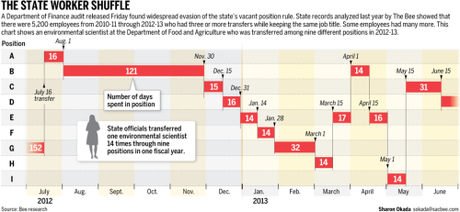
Sacramento Bee: A new state audit concludes that California state departments illegally pad their budgets with millions of tax dollars earmarked for employee salaries by manipulating their payroll to make it appear they have more employees than they do.
The report released Friday on the Department of Finance’s website did not include an estimate of how much money departments hoard by breaking the law, but it confirms a 2014 Sacramento Bee investigation that concluded tens of millions of tax dollars earmarked to pay workers is hoarded and funneled to other purposes.
By law, departments are supposed to forfeit money for a position that goes unfilled for six months, returning it to its source fund for reallocation. But as The Bee’s report and the new state audit found, departments deceptively move employees between jobs ahead of the six-month deadline. They accomplish the phony transfers by altering the identifying job numbers to make it appear that a position was filled with a transferred employee, thus avoiding a cut to their budgets.
The unspent salary can then be used for other operating costs, such as paying off leave balances, covering office rent, purchasing new equipment or funding employee raises. The Bee found instances of employees “transferring” between positions in as little as two days. In one instance, a Department of Food and Agriculture worker moved 14 times through nine positions in one fiscal year. Her title and workplace never changed, but the serial numbers the state used to identify her position changed repeatedly.
The audit was based on a sample of 798 “transactions” in which multiple transfers occurred in 10 departments. It found “widespread noncompliance” with the law: 58 percent of the transactions “lacked adequate justification or documentation to determine compliance or were found to be noncompliant.” It did not name individual departments.
It also described a “general lack of commitment” by managers and other top department officials to follow the vacancy rules. It said they plotted about how to avoid them. “We observed a culture at some departments where circumvention of the code was commonplace and even encouraged by management,” the audit read.
Among the other findings:
- At one department, the same employee was transferred into multiple positions. The department could offer no justification for the transfers and “noted that these types of transfers were typically initiated to preserve the positions.”
- Most transfers of employees to vacant positions lacked adequate documentations. At one department, 104 of 118 transfers lacked supporting documentations.
- Several departments changed employees’ position numbers, even if there were no changes in an employee’s job description or funding source.
- In one department, units routinely swapped vacant positions closing in on the six-month threshold with positions that had been vacant for a shorter amount of time. There are no state policies regulating the movement of vacant positions within a department.
- The state rule is based on the honor system. All 10 departments said they complied with the rule. Auditors, though, found that nine were not in full compliance.
The audit noted that departments face no penalties for violating the law. “In the absence of specific accountability measures, consequences or penalties, departments appear willing to circumvent the code to preserve positions,” the audit read.
Some departments justified the vacancy shuffling by telling auditors it sometimes took longer than six months to fill a position. Departments have the ability to restore a position that has been eliminated, but department managers viewed that process as onerous and with no guarantees that they would get the position back, the audit said. “Instead, departments have chosen noncompliance out of convenience and to reduce the risk of permanently losing the positions,” the audit said.
The report notably lacks any estimate of how much money the illegal vacancy maneuvers diverted from other state programs and uses. The Bee 2014 investigation estimated, conservatively, that the average total pay shielded by illegal transfers in 2012 and 2013 was at least $80 million.

The audit offered several recommendations. Officials could abolish the 2012 rule and create a new one that includes a process for monitoring departments’ compliance, it said. Or officials could increase oversight of departments’ compliance with the existing rule.
Lynda Gledhill, spokeswoman for the California Government Operations Agency, said the administration will present its response next month. “The state must focus on recruiting and retaining the best available workforce and the May Revision will include specific proposals to respond to the issues raised in the audit,” she said in a statement.
Jon Coupal, president of the Howard Jarvis Taxpayers Association, said the practice lets the government hide money. “The state has been caught red-handed engaging in what appears to be intentional personnel mismanagement,” he said. “It’s contrary to the notion of transparency in government. This practice has got the stop and those responsible for it held accountable and reprimanded.”

DCG

